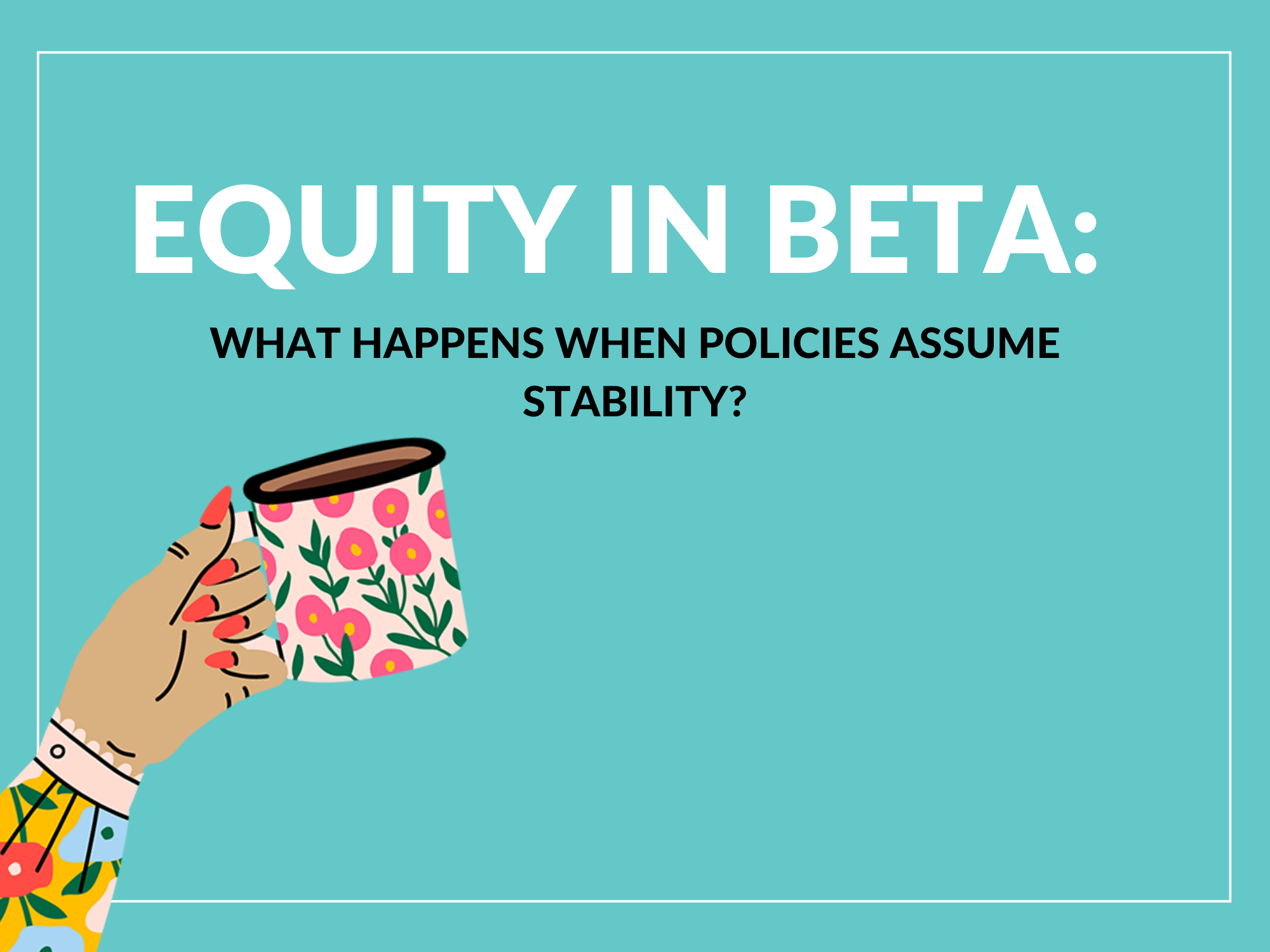Equity in Beta: What Happens When Policies Assume Stability?
About Equity in Beta
Equity in Beta is a recurring QuakeLab publication that explores how systems, policies, and services produce inequity through design. Each edition opens up one practical question and tests it using our framework of equity as a technical skill. The series treats equity work as experimentation: precise, iterative, and evidence-based, where every organization can examine how its systems perform under real conditions.
In many organizations, policy design is treated as a neutral technical exercise: set the rules, define the limits, and publish them. The goal is order, consistency, and compliance. Yet every policy is a record of assumptions. It reflects the worldview of the people who wrote it and the moment it was written in.
Financial and administrative policies, in particular, often assume a workforce with stable income, access to credit, flexible time, and minimal competing demands. These assumptions were baked into policy design long before today’s realities of precarious work, dual-income households, and rising debt. For decades, the model of the “ideal employee” in administrative systems was built around a single, uninterrupted career and a secure household. The systems that served that worker became the default settings of employment policy.
Reimbursement systems are a clear example. They ask staff to pay upfront and wait for repayment, assuming every employee has the means to carry those costs. Relocation policies frequently reimburse only after expenses are submitted, requiring workers to float thousands of dollars on credit. Home-office stipends or technology allowances often assume staff can make purchases immediately and claim them later. These mechanisms appear neutral but encode an assumption of stability.
When we analyze inequity inside organizations, financial policy is one of the clearest windows into design bias. The movement of money exposes where systems assume capacity and where they shift risk downward. The issue is not whether policies are fair in theory but whether they distribute time, risk, and debt equitably in practice.
A structured diagnostic helps organizations identify the technical gaps. When reviewing a policy, we examine:
Purpose: What outcome the policy is designed to make possible, and for whom.
Assumptions: What the policy expects people to already have? Savings, credit, flexibility, or time.
Exclusions: Who encounters barriers or incurs risk because they cannot meet those expectations.
Alternatives: What changes the organization could absorb to reduce or eliminate those risks.
Across organizations, similar patterns repeat. Expense reimbursement systems routinely create disproportionate pressure for staff with less financial flexibility. Professional development programs that reimburse after completion exclude employees who cannot front training fees. Relocation and travel allowances often penalize renters and caregivers who cannot afford overlapping expenses. Even policies meant to support well-being, such as technology stipends or wellness funds, can create new forms of inequity when their design presumes everyone can pay first and claim later.
These are not isolated administrative details; they are mechanisms that shape participation. When left unexamined, they create predictable forms of exclusion. The result is that employees with similar salaries experience very different financial realities.
Across Canada, the financial terrain employees navigate is far from equal. As of 2024, the ratio of household debt to disposable income in Canada reached roughly 172%, meaning the average household owed nearly $1.72 for every dollar earned. Lower-income households carry the highest relative debt burdens. The average non-mortgage debt for Canadians aged 46 to 55 was approximately $72,000, and debt servicing costs continue to rise faster than wages.
For many, those financial pressures intersect with persistent pay inequities. The national gender wage gap remains around 11%, meaning women earn approximately 89 cents for every dollar earned by men in full-time roles. Immigrant women who arrived as adults earn roughly 21% less than Canadian-born men, and Indigenous women experience a gap of about 20%. Black and racialized workers are overrepresented in lower-wage occupations, and data from Statistics Canada continues to show that racialized Canadians face higher levels of income volatility and unsecured debt.
The outcome is that two employees with the same gross pay may have radically different access to liquidity, credit, and stability. Financial policy design that assumes equivalence across staff will therefore reproduce inequity, not through intent, but through structure.
Financial policy design determines far more than compliance. It shapes how talent moves through an organization, who accepts or declines opportunities, and how quickly projects move from idea to execution. When policies transfer financial risk to employees, they create hidden friction that affects retention, engagement, and delivery. Delays in reimbursement become delays in implementation. Missed training or travel becomes missed visibility and advancement. Over time, these inefficiencies accumulate into measurable losses like slower timelines, narrower participation, and higher turnover among precisely the people organizations can least afford to lose.
Designing for equity
Policy design can be rebuilt to account for this variation without sacrificing efficiency. Some of the most effective changes are simple:
Replace reimbursement-only systems with options for advances or direct vendor payments.
Shorten repayment timelines and monitor cycle times by role or income band.
Offer flexible timing for relocation or equipment purchases based on demonstrated need.
Regularly review policy data to identify where delays or administrative steps create concentration of burden.
In one municipal client, replacing post-travel reimbursements with pre-approved vendor payments reduced administrative processing time by 40% and eliminated a recurring source of staff complaints. The redesign required no additional funding, only different sequencing and clearer definitions of responsibility.
These changes are neither moral gestures nor acts of generosity. They are technical improvements that align policy intent with real-world conditions.
To accompany this piece, QuakeLab has developed the Expense Equity Mini-Diagnostic, a short tool for identifying where financial policies assume stability. The diagnostic is available for purchase through our Resource Store, or you can receive it free by subscribing to the QuakeLab newsletter.
Policies shape experience, the assumptions within them decide who carries cost and who enjoys stability. Learning to identify those assumptions with technical precision is one of the most valuable design skills any organization can build.

